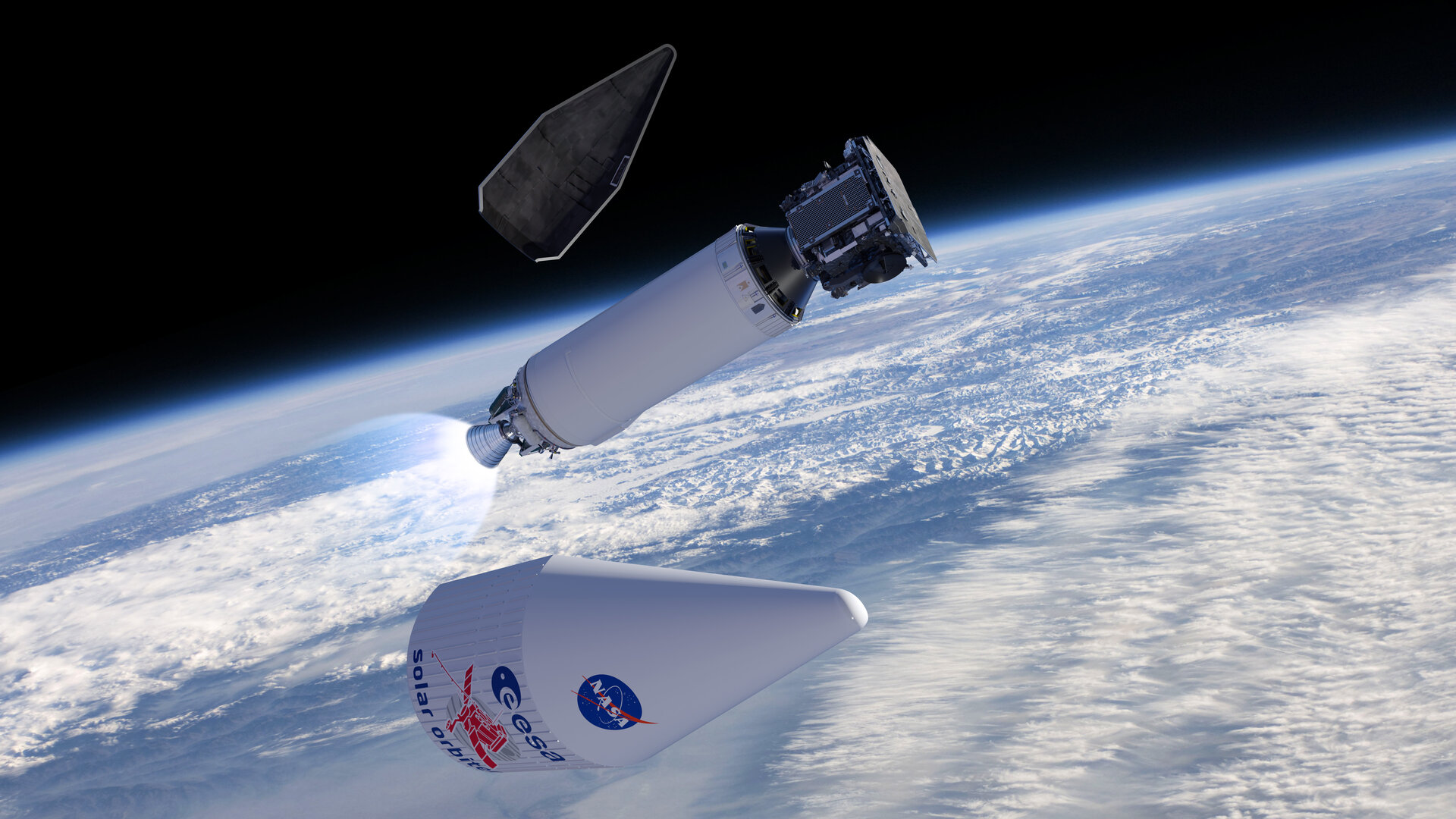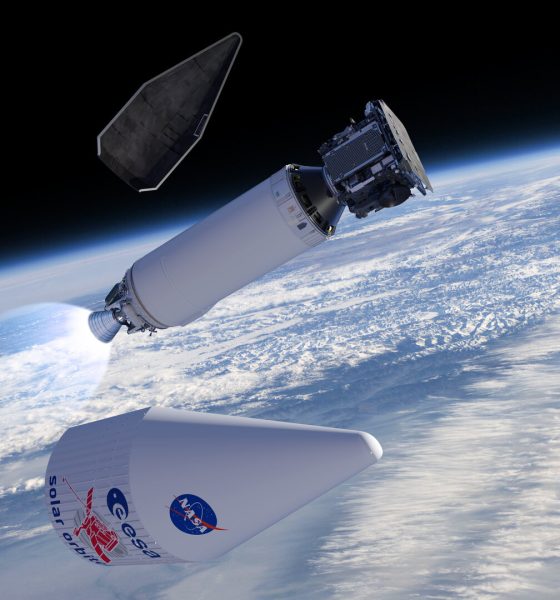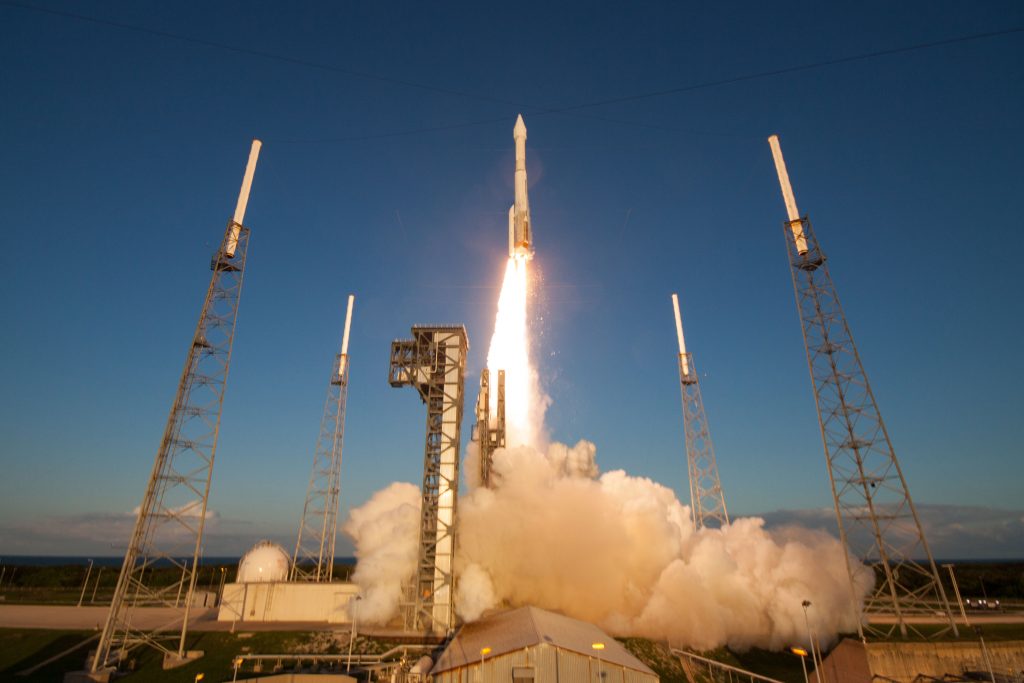

News
ULA rocket set to launch Solar Orbiter as NASA, ESA near golden era of sun science
Just a year and a half after sending NASA’s Parker Solar Probe to study the Sun, United Launch Alliance (ULA) is ready to once again support a science mission on its way to the center of our solar system. The Solar Orbiter, a unique spacecraft jointly developed by NASA and the European Space Agency, will launch aboard a ULA Atlas V 411 booster, propelling it to the Sun to snap the first photos of its north and south poles.

The Solar Orbiter will work in conjunction with NASA’s Parker Solar Probe in unlocking the mysteries of our closest star. Parker Solar Probe occasionally dips into the Sun’s atmosphere – referred to as the corona – learning about the environment and the solar wind that propels energy and radiation into our solar system. The Solar Orbiter will – as the name suggests – orbit the Sun, but will remain further away than Parker (about 26 million miles away) allowing it to produce the first images of the Sun’s northern and southern poles. This advancement could potentially offer more insight into the Sun’s powerful magnetic field.
The ULA Atlas V 411 booster arrived in Florida back in November 2019. Since the completion of the previous Atlas V mission that supported the Boeing Starliner Orbital Flight Test in December 2019, ULA has been continuously prepping for the launch of the Solar Orbiter. In early January 2020, the booster was vertically hoisted into ULA’s Vertical Integration Facility. Following final booster preparations, including rolling it out to the launchpad for pre-launch testing twice, the safely encapsulated Solar Orbiter payload was carefully stacked on top during final integration on January 31st.

According to ULA, the Atlas V 411 configuration was selected to provide the necessary “Earth departure trajectory for making repeated close encounters with the sun.” The configuration used to launch the Solar Orbiter consists of a dual-nozzle main engine and one solid-fuel booster mounted to the side. This allows the rocket to utilize steering capability provided by the main engine while maintaining a center of gravity stabilized by the additional booster. ULA states that while this is a rather unique configuration, it is one that has been successfully utilized to support missions five times since 2006.

Ahead of the February 9th launch attempt, teams rolled the mighty Atlas V 411 out to the launchpad at Space Launch Complex-41 at Cape Canaveral Air Force Station to complete a full Wet Dress Rehearsal (WDR) – a full run-through of launch day operations including fueling the rocket and proceeding through terminal count. The first attempt at WDR resulted in a minor delay of launch due to a “wind-blown ECS cold air duct” that had to be replaced before testing could be completed, according to CEO of ULA, Tory Bruno. The second attempt of the WDR on January 24th was completed without a hitch.
On Friday morning February 7th, Bruno announced that all of pre-flight rehearsals and verifications were completed and the Solar Orbiter was ready to begin its journey to the Sun.
Currently, ULA and NASA are targeting a launch on Sunday, February 9th at 11:03 pm EST (0403 UTC) with a two-hour launch window. The launch weather is at 80% “GO” conditions with cumulus clouds as the primary concern for violation. Should the launch need to 24-hr recycle for a launch attempt on Monday, February 10th, weather conditions deteriorate slightly to 70% “GO.”
A live launch webcast will be provided on NASA TV beginning approximately 30 minutes prior to lift-off at 10:30 pm EST (0330 UTC).
Check out Teslarati’s newsletters for prompt updates, on-the-ground perspectives, and unique glimpses of SpaceX’s rocket launch and recovery processes.

Elon Musk
Elon Musk and Tesla AI Director share insights after empty driver seat Robotaxi rides
The executives’ unoccupied tests hint at the rapid progress of Tesla’s unsupervised Robotaxi efforts.

Tesla CEO Elon Musk and AI Director Ashok Elluswamy celebrated Christmas Eve by sharing personal experiences with Robotaxi vehicles that had no safety monitor or occupant in the driver’s seat. Musk described the system’s “perfect driving” around Austin, while Elluswamy posted video from the back seat, calling it “an amazing experience.”
The executives’ unoccupied tests hint at the rapid progress of Tesla’s unsupervised Robotaxi efforts.
Elon and Ashok’s firsthand Robotaxi insights
Prior to Musk and the Tesla AI Director’s posts, sightings of unmanned Teslas navigating public roads were widely shared on social media. One such vehicle was spotted in Austin, Texas, which Elon Musk acknowleged by stating that “Testing is underway with no occupants in the car.”
Based on his Christmas Eve post, Musk seemed to have tested an unmanned Tesla himself. “A Tesla with no safety monitor in the car and me sitting in the passenger seat took me all around Austin on Sunday with perfect driving,” Musk wrote in his post.
Elluswamy responded with a 2-minute video showing himself in the rear of an unmanned Tesla. The video featured the vehicle’s empty front seats, as well as its smooth handling through real-world traffic. He captioned his video with the words, “It’s an amazing experience!”
Towards Unsupervised operations
During an xAI Hackathon earlier this month, Elon Musk mentioned that Tesla owed be removing Safety Monitors from its Robotaxis in Austin in just three weeks. “Unsupervised is pretty much solved at this point. So there will be Tesla Robotaxis operating in Austin with no one in them. Not even anyone in the passenger seat in about three weeks,” he said. Musk echoed similar estimates at the 2025 Annual Shareholder Meeting and the Q3 2025 earnings call.
Considering the insights that were posted Musk and Elluswamy, it does appear that Tesla is working hard towards operating its Robotaxis with no safety monitors. This is quite impressive considering that the service was launched just earlier this year.
Elon Musk
Starlink passes 9 million active customers just weeks after hitting 8 million
The milestone highlights the accelerating growth of Starlink, which has now been adding over 20,000 new users per day.

SpaceX’s Starlink satellite internet service has continued its rapid global expansion, surpassing 9 million active customers just weeks after crossing the 8 million mark.
The milestone highlights the accelerating growth of Starlink, which has now been adding over 20,000 new users per day.
9 million customers
In a post on X, SpaceX stated that Starlink now serves over 9 million active users across 155 countries, territories, and markets. The company reached 8 million customers in early November, meaning it added roughly 1 million subscribers in under seven weeks, or about 21,275 new users on average per day.
“Starlink is connecting more than 9M active customers with high-speed internet across 155 countries, territories, and many other markets,” Starlink wrote in a post on its official X account. SpaceX President Gwynne Shotwell also celebrated the milestone on X. “A huge thank you to all of our customers and congrats to the Starlink team for such an incredible product,” she wrote.
That growth rate reflects both rising demand for broadband in underserved regions and Starlink’s expanding satellite constellation, which now includes more than 9,000 low-Earth-orbit satellites designed to deliver high-speed, low-latency internet worldwide.
Starlink’s momentum
Starlink’s momentum has been building up. SpaceX reported 4.6 million Starlink customers in December 2024, followed by 7 million by August 2025, and 8 million customers in November. Independent data also suggests Starlink usage is rising sharply, with Cloudflare reporting that global web traffic from Starlink users more than doubled in 2025, as noted in an Insider report.
Starlink’s momentum is increasingly tied to SpaceX’s broader financial outlook. Elon Musk has said the satellite network is “by far” the company’s largest revenue driver, and reports suggest SpaceX may be positioning itself for an initial public offering as soon as next year, with valuations estimated as high as $1.5 trillion. Musk has also suggested in the past that Starlink could have its own IPO in the future.
News
NVIDIA Director of Robotics: Tesla FSD v14 is the first AI to pass the “Physical Turing Test”
After testing FSD v14, Fan stated that his experience with FSD felt magical at first, but it soon started to feel like a routine.

NVIDIA Director of Robotics Jim Fan has praised Tesla’s Full Self-Driving (Supervised) v14 as the first AI to pass what he described as a “Physical Turing Test.”
After testing FSD v14, Fan stated that his experience with FSD felt magical at first, but it soon started to feel like a routine. And just like smartphones today, removing it now would “actively hurt.”
Jim Fan’s hands-on FSD v14 impressions
Fan, a leading researcher in embodied AI who is currently solving Physical AI at NVIDIA and spearheading the company’s Project GR00T initiative, noted that he actually was late to the Tesla game. He was, however, one of the first to try out FSD v14.
“I was very late to own a Tesla but among the earliest to try out FSD v14. It’s perhaps the first time I experience an AI that passes the Physical Turing Test: after a long day at work, you press a button, lay back, and couldn’t tell if a neural net or a human drove you home,” Fan wrote in a post on X.
Fan added: “Despite knowing exactly how robot learning works, I still find it magical watching the steering wheel turn by itself. First it feels surreal, next it becomes routine. Then, like the smartphone, taking it away actively hurts. This is how humanity gets rewired and glued to god-like technologies.”
The Physical Turing Test
The original Turing Test was conceived by Alan Turing in 1950, and it was aimed at determining if a machine could exhibit behavior that is equivalent to or indistinguishable from a human. By focusing on text-based conversations, the original Turing Test set a high bar for natural language processing and machine learning.
This test has been passed by today’s large language models. However, the capability to converse in a humanlike manner is a completely different challenge from performing real-world problem-solving or physical interactions. Thus, Fan introduced the Physical Turing Test, which challenges AI systems to demonstrate intelligence through physical actions.
Based on Fan’s comments, Tesla has demonstrated these intelligent physical actions with FSD v14. Elon Musk agreed with the NVIDIA executive, stating in a post on X that with FSD v14, “you can sense the sentience maturing.” Musk also praised Tesla AI, calling it the best “real-world AI” today.








